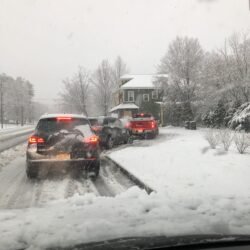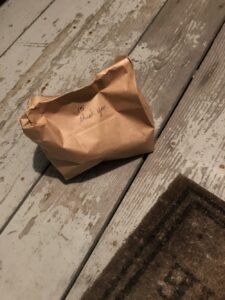Mainers have rallied around their favorite restaurants by ordering pickup and delivery while we observe stay-at-home orders. The widespread availability of takeout food, even from some of the state’s finer restaurants, is a game changer for the consumer. But if we want it to last, we have to learn the rules – and mind our manners. Here are some tips for navigating (and getting the most enjoyment from) the takeout scene:

The takeout line at Noble BBQ snaked down Forest Avenue during a spring storm. Photo by Meredith Goad
DO seek variety. And by variety, we mean not only different dishes and different restaurants, but a variety of foods. Pizza and fried chicken are not food groups. Immune systems need to be nurtured, so throw in a salad once in a while.
DON’T forget your credit card. Most places require pre-ordering, but some businesses want you to pay when you pick up your order, and many are not accepting cash. (A dollar bill is one of the germiest things on the planet, rivaling dish sponges and cell phones, according to many medical researchers.)
DO try something that you don’t ordinarily make at home. Chances are you have pounds of hoarded packages of spaghetti in your pantry, so spend your money on shawarma or saag paneer instead. But DO, also, give yourself a break: if you are cash-strapped and kinda depressed and just want the poke from your favorite poke shop. Ordering from a different place, or trying that interesting-sounding dish that turns out to be meh, will not bring you the comfort during these stressful times that you thought it would.
DON’T worry about your order’s temperature. A rumor that’s getting a lot of airplay says that it’s better to order hot food since heat kills the coronavirus. Another says that consumers should microwave their takeout before they eat it for the same reason. Nope, and nope, says Michele Pfannenstiel, a food safety consultant from Yarmouth. “Hot food is not safer than cold food,” she said “One, because the virus is not known to transmit through food.” And two, those recommendations are based on a single 2004 study in which a similar virus was killed by heating it for three minutes at 149 degrees – and it wasn’t even the same coronavirus that we’re dealing with now.“Order what you want,” Pfannenstiel said.
DO consider ordering directly from the restaurant. When it comes to fees, delivery services can be as wonky as the airlines, but instead of paying more for extra baggage and premium seats, restaurants pay commissions, activation fees and other add-on charges to companies like Grubhub and Uber Eats. These fees can be hard for restaurants to swallow during normal times, much less when they are in survival mode. Picking an order up directly from the restaurant will also get you out of the house, however briefly.
DON’T be shy about wearing a mask when you pick up your order. It may feel like an inconvenience to you, but it’s important to the person handling your food – the person who deals with many customers, day after day, and wants to stay safe.
DO watch your bank account. While we all want to support restaurants, if you’ve lost your job or are living paycheck to paycheck, those $5-10 delivery fees, on top of the cost of the meals, will add up fast. If that sounds like you, and you feel the urge for dinner from your favorite restaurant, check to see if they do curbside pick-up and save yourself a few bucks.
DON’T forget the beer, wine or cocktails. Many restaurants are selling beer and wine, sometimes at generous discounts, along with their crab cakes and lobster stew. And the state has revised the rules so that restaurants can sell the draft beer they have on hand in growlers, or cocktails to go, as long as they’re ordered with food. Alcohol sales have long been a boost to restaurants’ bottom lines, so if you were going to have a beer anyway, you might as well buy it directly from the restaurant. Craft brewers and distillers would also appreciate your support, either through a direct purchase or through delivery services such as Car Hop and Drizzly.

Jessica Sueltenfuss, co-owner of Other Side Diner in Portland, hands over Sunday brunch through the restaurant’s takeout window. Photo by Meredith Goad
DO read the instructions for curbside pick-up. Some restaurants have a straightforward process – just drive up and a staff member brings your meal out to your car. Others are a little more complicated, and it’s a good idea to familiarize yourself with the process before you head out to pick up your food. At Scratch Baking in South Portland, for example, the staff prefers that you hold a piece of paper with your name on it up to the car window rather than rolling the window down – an extra measure of protection. Then you unlock your back door or your trunk so you never have direct contact with the staffer bringing you the food. You need to know the rules ahead of time so you are sure to bring that paper with you. At Noble BBQ in Portland, the owner has set up a drive-thru lane to pick up online orders. The Other Side Diner in Portland is serving Sunday brunch through a takeout window we didn’t even know it had. And The Good Table in Cape Elizabeth, which has turned an ordinary window into a take-out window, asks that customers approach from the ramp on the left side of the porch, which is better for social distancing than the more direct route up the porch stairs. If you’re not paying attention and reading instructions, you’ll slow things down for everyone.
DON’T be that person who shows up too late for their pickup time and makes the line even longer.
DO be patient (Part 1). There are going to be glitches. Restaurateurs are doing their best under difficult circumstances, but sometimes something goes wrong. We waited an hour for an order at one place. In ordinary times that would have been frustrating, but we just turned on the radio, took a few deep breaths, and felt thankful we were healthy and still had a job.
DON’T forget to tip. Drivers for delivery services are under a lot more strain during the pandemic both since they risk potential exposure to the virus and demand for their services has exploded; a staffer at 2DineIn told us that they can’t hire drivers fast enough.
DO follow proper procedures when your food arrives. Both the FDA and the CDC say there’s no evidence of food, food containers or food packaging transmitting COVID-19. Concern about packaging was sparked by a single study published in March that said coronavirus can linger on cardboard and plastics – under very specific conditions. If you are worried regardless, and want to be extra careful, remove the food from its packaging and put it on a clean plate. Throw away the packaging immediately, disinfect the surface it sat on, and wash your hands before eating.
DON’T forget to spread the love. Try a different restaurant each time you order so you can help as many small businesses as possible.
DO be patient (Part 2). If your order is late, remember that the people preparing it are juggling a thousand tasks, and often they are doing it alone. Some chefs are putting in a superhuman number of hours just so they can offer a couple of days’ worth of takeout. When you’re given a 6:15 p.m. pickup time at Chaval, for example, chef Damian Sansonetti (who is doing all the cooking himself) is likely firing your meal at 6 p.m. because he wants it to be as close to a restaurant experience as possible. And he’s not cooking just to save his restaurant. The first five weeks of takeout at Chaval paid for health insurance for his staff no longer working there. The chef sets aside one day a week to cook for hospital workers, and another day to prepare food for Preble Street Resource Center. If you have to wait 15 minutes for your steak or coq au vin, in the grand scheme of things that’s not a big deal.
DON’T overlook essential workers. Many restaurants are also cooking food for frontline health care workers. Consider making a donation when you order so those workers can have a hot meal while they are saving lives.
DO choose no-contact delivery when you can. All deliveries from 2-Dine In are now no-contact deliveries. The delivery person leaves the food at your door, then calls when they are a safe distance away to inform you that it has been dropped off.

Many restaurants and delivery services are offering no-contact delivery during the pandemic. Photo by Meredith Goad
DON’T forego social distancing. Even when your delivery driver shows up at your door looking like a bandit from the Old West, keep a storm door between you. You may feel comfortable, but respect that they may need that extra space to feel safe.
DO listen to what chefs and restaurateurs have to say. When we asked them what they would say to their take-out customers, they didn’t complain about no-shows or long lines or customer demands. Overwhelmingly, they said, simply, thank you:
“Thank you thank you thank you. For all the love, support, understanding, generosity. It’s been a rocky road, and we for sure would close if not for the continued encouragement.” – Austin Miller, chef/co-owner of Mami in Portland.
“We want to thank all of the guests that have supported us. We love feedback. We want to give you what you want, what you need. Tell us!” – Melissa Kelly, chef/owner of Primo in Rockland.
“Slab Sicilian Street Food is speechless. We have been supported so much by our community. The patrons have been amazing through all of this.” – Jason Loring, owner of Slab in Portland.
“I feel the customers have been really patient, overly generous and understanding of the situation. I just want them all to know that we appreciate their support.” – Daron Goldstein, chef/owner of Provender Kitchen + Bar in Ellsworth.
“I want to hug them all and tell them how much I sincerely appreciate them. They are literally keeping the roof on our two businesses and groceries in the cabinet for my family, and being heartwarmingly supportive in every way.” – Christian Hayes, chef/co-owner of The Garrison and Dandelion Catering in Yarmouth.
“The support from all our guests has been amazing. They have waited and worked through us switching and adapting and (have been) understanding. I’m not a big hugger usually, but I want to give them all a big hug of thank you for us and our hospitality community. Thank you, thank you, thank you.” – Damian Sansonetti, chef/co-owner of Chaval in Portland.
Dine In Maine: Dinner and a movie
Homefront: Home-baked bread is within your grasp
coronavirus, maine businesses, maine restaurants, Restaurants
Invalid username/password.
Please check your email to confirm and complete your registration.
Use the form below to reset your password. When you’ve submitted your account email, we will send an email with a reset code.